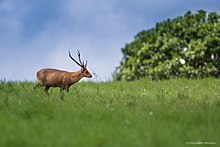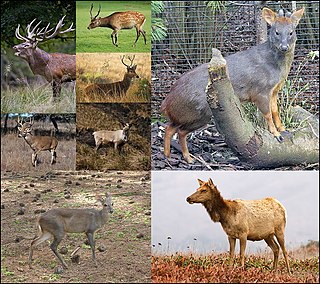
A deer or true deer is a hoofed ruminant mammal of the family Cervidae. The two main groups of deer are the Cervinae, including muntjac, elk (wapiti), red deer, and fallow deer; and the Capreolinae, including reindeer (caribou), white-tailed deer, roe deer, and moose. Male deer of all species, as well as female reindeer, grow and shed new antlers each year. In this, they differ from permanently horned antelope, which are part of a different family (Bovidae) within the same order of even-toed ungulates (Artiodactyla).

The Père David's deer, also known as the milu or elaphure, is a species of deer native to the subtropical river valleys of China. It grazes mainly on grass and aquatic plants. It is the only extant member of the genus Elaphurus. Some experts suggest demoting Elaphurus to a subgenus of Cervus. Based on genetic comparisons, Père David's deer is closely related to Eld's deer.

Eld's deer, also known as the thamin or brow-antlered deer, is an endangered species of deer endemic to South and Southeast Asia.
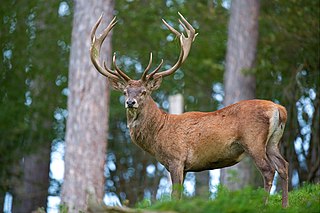
The red deer is one of the largest deer species. A male red deer is called a stag or hart, and a female is called a hind. The red deer inhabits most of Europe, the Caucasus Mountains region, Anatolia, Iran, and parts of western Asia. It also inhabits the Atlas Mountains of Northern Africa; being the only living species of deer to inhabit Africa. Red deer have been introduced to other areas, including Australia, New Zealand, the United States, Canada, Peru, Uruguay, Chile and Argentina. In many parts of the world, the meat (venison) from red deer is used as a food source.

The sambar is a large deer native to the Indian subcontinent, South China and Southeast Asia that is listed as a vulnerable species on the IUCN Red List since 2008. Populations have declined substantially due to severe hunting, local insurgency, and industrial exploitation of habitat.

The chital or cheetal, also known as the spotted deer, chital deer and axis deer, is a deer species native to the Indian subcontinent. It was first described and given a binomial name by German naturalist Johann Christian Polycarp Erxleben in 1777. A moderate-sized deer, male chital reach 90 cm (35 in) and females 70 cm (28 in) at the shoulder. While males weigh 70–90 kg (150–200 lb), females weigh around 40–60 kg (88–132 lb). It is sexually dimorphic; males are larger than females, and antlers are present only on males. The upper parts are golden to rufous, completely covered in white spots. The abdomen, rump, throat, insides of legs, ears, and tail are all white. The antlers, three-pronged, are nearly 1 m long.
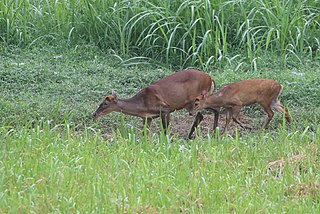
The Southern red muntjac is a deer species native to Southeast Asia. It was formerly known as the Indian muntjac or the common muntjac before the species was taxonomically revised to represent only populations of Sunda and perhaps Malaysia. The other populations being attributed to this species are now attributed to Muntiacus vaginalis. Muntjacs are also referred to as barking deer. It is listed as Least Concern on the IUCN Red List.

Thorold's deer is a threatened species of deer found in grassland, shrubland, and forest at high altitudes in the eastern Tibetan Plateau. It is also known as the white-lipped deer for the white patches around its muzzle.

The barasingha, sometimes barasinghe, also known as the swamp deer, is a deer species distributed in the Indian subcontinent. Populations in northern and central India are fragmented, and two isolated populations occur in southwestern Nepal. It has been extirpated in Pakistan and Bangladesh, and its presence is uncertain in Bhutan.

The Kashmir stag, also called hangul, is a subspecies of Central Asian red deer endemic to Kashmir and its surrounding areas. It is found in dense riverine forests in the high valleys and mountains of the Indian Himalayas in the states of Jammu and Kashmir and northern Himachal Pradesh. In Kashmir, it is found primarily in the Dachigam National Park where it receives protection, and elsewhere it is more at risk. In the 1941s, the population was between 3000 and 5000 individuals, but since then habitat destruction, over-grazing by domestic livestock and poaching have reduced population dramatically. Earlier believed to be a subspecies of red deer, a number of mitochondrial DNA genetic studies later had the hangul as a part of the Asian clade of the elk. The IUCN and American Society of Mammalogists, however, include it in the new grouping of Central Asian red deer, with the Kashmir stag being the type subspecies. The 2008 census counted 160 mature individuals in the Kashmir valley and northern Chamba in Himachal Pradesh. According to the census in 2019, there were only 237 hanguls. According to 2023 census, the numbers have improved to 289.

Deer hunting is hunting for deer for meat and sport, an activity which dates back tens of thousands of years. Venison, the name for deer meat, is a nutritious and natural food source of animal protein that can be obtained through deer hunting. There are many different types of deer around the world that are hunted for their meat. For sport, often hunters try to kill deer with the largest and most antlers to score them using inches. There are two different categories of antlers. They are typical and nontypical. They measure tine length, beam length, and beam mass by each tine. They will add all these measurements up to get a score. This score is the score without deductions. Deductions occur when the opposite tine is not the same length as it is opposite. That score is the deducted score.

The Philippine deer, also known as the Philippine sambar or Philippine brown deer, is a vulnerable deer species endemic to the Philippines. It was first described from introduced populations in the Mariana Islands, hence the specific name.
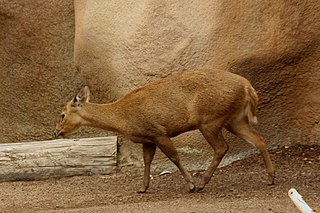
The Calamian deer, also known as Calamian hog deer, is an endangered species of deer found only in the Calamian Islands of Palawan province in the Philippines. It is one of three species of deer native to the Philippines, the other being the Philippine sambar and the Visayan spotted deer.
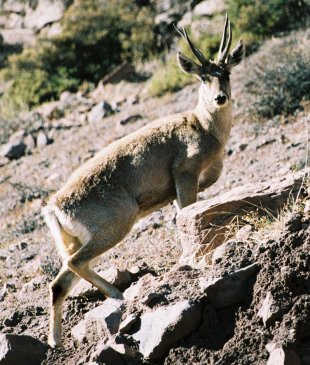
The taruca, also known as the Peruvian guemal, north Andean deer, north Andean huemul, northern huemul or northern guemal, is a mid sized deer species that inhabits the high regions of the Andes mountains in South America. The common name taruca means "deer" in both the Quechua and Aymara languages, though these are not interrelated. The taruca is closely related to the southern guemal, the only other member of the Hippocamelus genus.
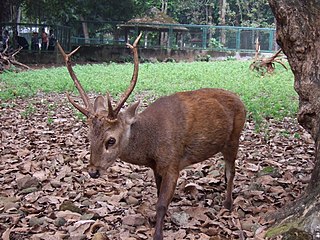
The Bawean deer, also known as Kuhl's hog deer or Bawean hog deer, is a highly threatened species of deer endemic to the island of Bawean in Indonesia. Due to ongoing habitat loss, small population size and limited range, the Bawean deer is evaluated as critically endangered on the IUCN Red List of Threatened Species. It is listed on Appendix I of CITES. It has few natural enemies except for birds of prey and large snakes such as pythons.

Indawgyi Lake Wildlife Sanctuary is a biosphere reserve in Myanmar, covering 814.99 km2 (314.67 sq mi). It ranges in elevation from 105–1,400 m (344–4,593 ft) encompassing the surroundings of Indawgyi Lake in Mohnyin Township, Kachin State. It was gazetted in 2004, is recognized as an Important Bird Area and as one of the ASEAN Heritage Parks. An area of 478.84 km2 (184.88 sq mi) comprising the lake and the surrounding lowland is a Ramsar site since February 2016.
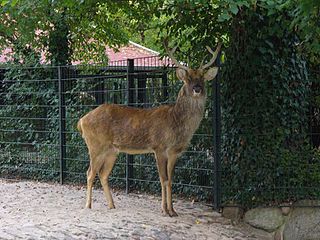
Rucervus is a genus of deer from India, Nepal, Indochina, and the Chinese island of Hainan. The only extant representatives, the barasingha or swamp deer and Eld's deer, are threatened by habitat loss and hunting; another species, Schomburgk’s deer, went extinct in 1938. Deer species found within the genus Rucervus are characterized by a specific antler structure, where the basal ramification is often supplemented with an additional small prong, and the middle tine is never present. The crown tines are inserted on the posterior side of the beam and may be bifurcated or fused into a small palmation.
The Barandabhar forest covers an area of 87.9 km2 and bisects the Chitwan District in east and west Chitwan. Barandabhar, a 29 km long forest patch, is bisected by the Mahendra Highway, resulting in a 56.9 km2 area in the buffer zone of RCNP and 31 km2 is under the district forest office.
Australia has a population of about 25 million, with the Commonwealth Government 2019 survey estimating there are 640,000 recreational hunters in the country. There are around 5.8 million legally owned guns in Australia, ranging from airguns to single-shot, bolt-action, pump-action, lever-action or semi-automatic firearms.
Prek Prasab Wildlife Sanctuary is a 12,770 ha protected area in eastern Cambodia, located in Kratié province. The area was formally protected in October 2018.
